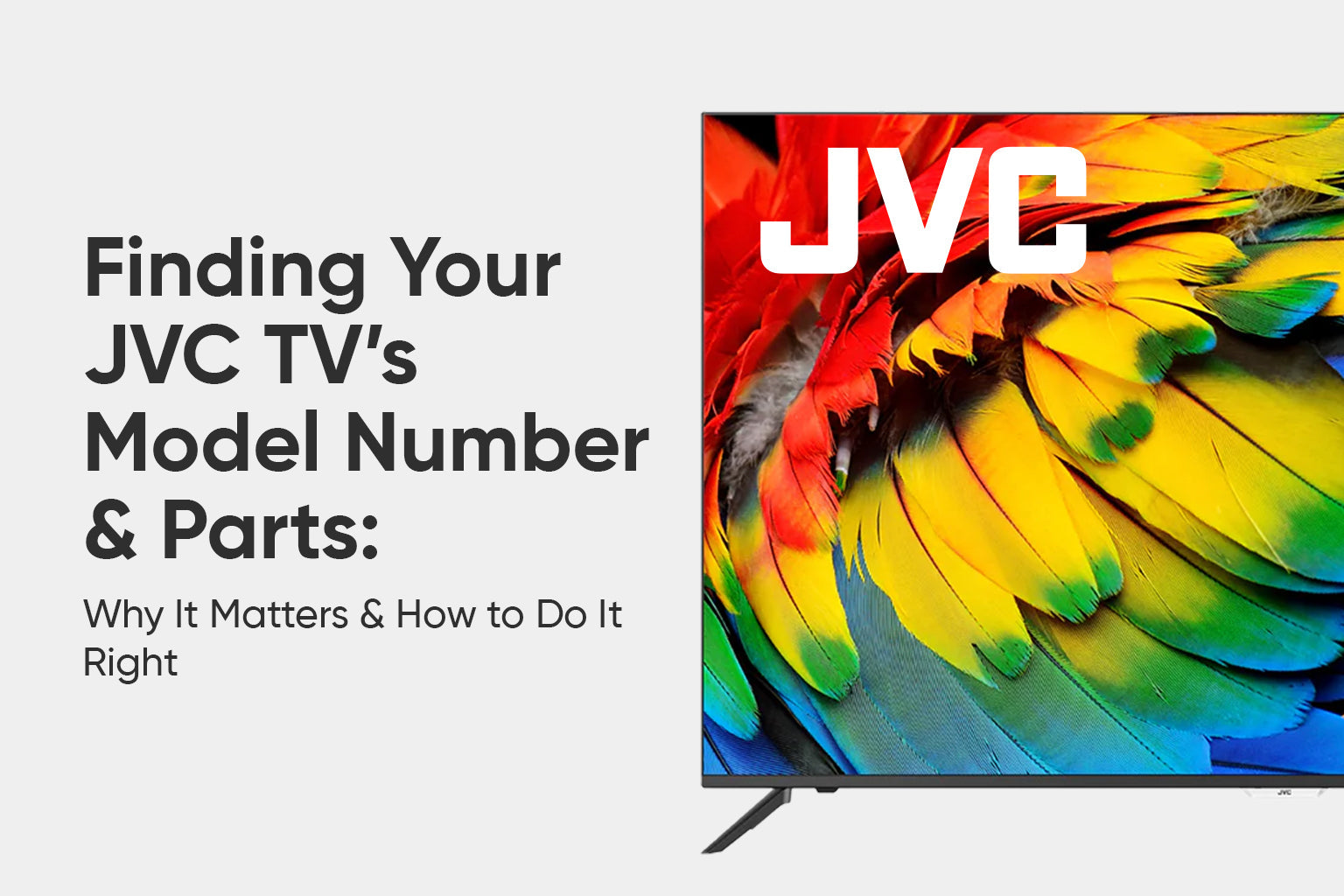Decoding the JVC TV Model Number Structure
Understanding JVC TV model numbers is crucial when searching for replacement parts. Each part of the model number provides vital information about your TV, making it easier to find the correct replacement part. Here's a breakdown of the typical JVC TV model number:
- Screen Size: The first part usually indicates the screen size (e.g., '55' means a 55-inch screen).
- Series Identifier: The following letters or numbers tell you about the TV series and its specific features.
- Region or Feature Information: The last part often includes details like the region, tuner type, or stand design.
By breaking down the model number, you'll be better equipped to find the right parts for your TV.
TVpartsToday Tip: Always use the exact part number to ensure compatibility and avoid ordering incorrect parts.
Ready to get started but not sure where to begin? Check out our helpful YouTube video below:
Comparing JVC TV Series and Models
When choosing a JVC TV, it's essential to understand the differences between the various series and models. JVC offers a range of TVs with unique features to meet different needs and budgets:
- Series Identification: JVC TVs are often categorized by technology (LED, Smart TVs) and are marked with series numbers or letters.
- Model Variations: Models within a series differ in size, resolution, sound quality, and smart features.
- Price Points: Higher-end models come with advanced features, while budget-friendly options balance cost and functionality.
TVpartsToday Tip: Compare the features and models before purchasing to ensure you select the one that best fits your preferences and needs.
Legacy vs. Current JVC TV Models
It’s important to distinguish between legacy and current JVC TV models:
- Legacy Models: Older, discontinued TVs may have harder-to-find parts, often requiring third-party vendors.
- Current Models: Actively sold TVs have more readily available parts and manufacturer support.
TVpartsToday Tip: Verify if your TV is a legacy model to avoid confusion when sourcing parts.
Identifying Common JVC TV Issues
Like all electronics, JVC TVs may encounter various issues over time. Here are some common problems:
- Power Issues: The TV may fail to turn on or experience intermittent power failures.
- Sound Problems: Audio may be distorted, absent, or not in sync with the video.
- Picture Quality Issues: Blank screens, lines, or poor color accuracy.
- Connectivity Troubles: HDMI or input ports may not work properly.
TVpartsToday Tip: Accurate troubleshooting before ordering parts can save time and money.
Troubleshooting Tips Before Ordering Parts
Before rushing to order replacement parts, try these troubleshooting steps:
- Check the Power Supply: Ensure the TV is plugged in and the outlet works.
- Examine Cables & Connections: Look for loose or damaged cables.
- Reset Your TV: Unplug it for a minute and then restart.
- Consult the Manual: Check for model-specific troubleshooting steps.
- Check for Software Updates: Outdated firmware can cause issues.
TVpartsToday Tip: Diagnose the issue thoroughly to avoid unnecessary part replacements. If unsure, give us a call.
Ensuring Compatibility with Your TV Model
Always check that the parts you’re purchasing are compatible with your specific JVC model. Here’s how:
- Cross-check the model number with the part’s compatibility list.
- Look for parts specifically designed for your TV series.
- Double-check product specs and dimensions for accuracy.
- Consult the manufacturer's website for further confirmation.
TVpartsToday Tip: Verify compatibility to avoid unnecessary repairs and potential damage to your TV.
DIY JVC TV Repair Guide
Tools and Safety Precautions
Before starting any repairs, gather the necessary tools and ensure your safety:
- Tools: Precision screwdrivers, needle-nose pliers, soft cloth, multimeter (optional).
- Safety: Unplug the TV, wear gloves and safety glasses to prevent accidents, and handle capacitors with caution.
TVpartsToday Tip: Safety should always be your top priority when repairing electronics.
Step-by-Step Instructions for Common Repairs
Here’s how to tackle common JVC TV repairs:
- Unplug the TV and place it on a flat, stable surface.
- Gather all necessary tools and parts.
- For example, when replacing the TV legs: Remove the old ones, align the new legs, and secure them with screws.
TVpartsToday Tip: Always consult the product manual for model-specific instructions.
Maintaining Your JVC TV for Longevity
Routine Cleaning and Care Tips
Keeping your JVC TV in top condition involves regular cleaning:
- Turn off and unplug the TV before cleaning.
- Use a soft, microfiber cloth to wipe the screen and avoid scratching.
- Dust vents with a small, soft-bristled brush.
TVpartsToday Tip: Keep your TV clean and well-maintained to ensure optimal performance for years.
Firmware Updates and Software Maintenance
Keeping your JVC TV updated is crucial for performance and security:
- Check for updates regularly through the Settings menu.
- Ensure your TV is connected to the internet for seamless software installation.
TVpartsToday Tip: Regular updates can enhance your TV’s features and fix known issues.
Avoiding Common Mistakes That Damage TVs
To extend your JVC TV’s lifespan, avoid these common mistakes:
- Placement: Ensure stability and adequate ventilation.
- Cleaning: Use soft cloths, not abrasive materials.
- Power Surges: Use a surge protector to prevent damage from voltage spikes.
- Volume: Keep the volume at a moderate level to preserve speaker life.
TVpartsToday Tip: Proper care can significantly extend the life of your JVC TV.
With these tips, your JVC TV will be well-maintained, and any necessary repairs will be a breeze!
Need Help?
If you’re still unsure about the issue or need to replace a part, reach out to TVpartsToday. We can help you identify the exact cause of the problem and provide the right replacement part!
Would you rather watch a video? Check out our helpful Troubleshooting 101 playlist over on YouTube!
Would you rather chat with a seasoned repair expert? Head on over to our TVRepairHelp subReddit!
Need help finding the right board or part?
Call us at 930-212-1975 or browse our inventory online.
DIY-friendly parts, fast shipping, and expert support – only at TVpartsToday.

